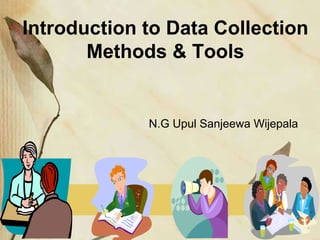
Introduction to Data Collection Methods Tools (1).ppt
- 1. Introduction to Data Collection Methods & Tools N.G Upul Sanjeewa Wijepala
- 2. Define Research Problem Review Concepts & Theories Literature Review Review previous research finding Formulate Hypothesis Research Design (Including sample design) Data Analysis Interpret and Report Data Collection (Using Data collection Tools) (Observation, Interview, Questionnaire etc.,..)
- 3. Data According to the Sources 1. Primary Sources Primary Data 2. Secondary Sources Secondary Data According to the Nature 1. Quantitative Data 2. Qualitative Data
- 4. Primary Data • Data never gathered before • Advantage: find data you need to suit your purpose • Disadvantage: usually more costly and time consuming than collecting secondary data • Collected after secondary data is collected
- 6. Secondary Data • Data gathered by another sources • Secondary data is gathered BEFORE primary data. WHY? • Because you want to find out what is already known about a subject/ Problem (L/R) before you dive into your own investigation. WHY? • Because some of your questions can possibly have been already answered by other investigators or authors. Why “reinvent the wheel”?
- 8. 8 Data Collection Strategies • No one best way: decision depends on: – What you need to know: numbers or stories – Where the data reside: environment, files, people – Resources and time available – Complexity of the data to be collected – Frequency of data collection – Intended forms of data analysis
- 9. IPDET © 2009 9 Which Data? - do not need to quantify the results - are not sure what you are able to measure Qualitative - want narrative or in-depth information - want to cover a large group - want to be precise - know what you want to measure Quantitative - want to conduct statistical analysis Then Use: If you:
- 10. Quantitative and Qualitative information (Quantity) Kids (5) (Quality) Happy
- 11. What method shall I use? There is no simple answer There is no ONE best method It all depends…
- 12. IPDET © 2009 12 Structured Approach • All data collected in the same way • Especially important for multi-site and cluster evaluations so you can compare • Important when you need to make comparisons with alternate interventions
- 13. IPDET © 2009 13 Use Structured Approach When: • Need to address extent questions • Have a large sample or population • Know what needs to be measured • Need to show results numerically • Need to make comparisons across different sites or interventions
- 14. IPDET © 2009 14 Semi-structured Approach • Systematic and follow general procedures but data are not collected in exactly the same way every time • More open and fluid • Does not follow a rigid script – may ask for more detail – people can tell what they want in their own way
- 15. IPDET © 2009 15 Use Semi-structured Approach when: • Conducting exploratory work • Seeking understanding, themes, and/or issues • Need narratives or stories • Want in-depth, rich information • Seek to understand results of data that are unexpected
- 16. IPDET © 2009 16 Quantitative Approach • Data in numerical form • Data that can be precisely measured – age, cost, length, height, area, volume, weight, speed, time, and temperature • Harder to develop • Easier to analyze
- 17. IPDET © 2009 17 Qualitative Approach • Data that deal with description • Data that can be observed or self-reported, but not always precisely measured • Less structured, easier to develop • Can provide “rich data” — detailed and widely applicable • Is challenging to analyze • Is labor intensive to collect • Usually generates longer reports
- 18. When choosing methods, consider… The purpose of your Research Will the method allow you to gather information that can be analyzed and presented in a way that will be credible and useful to you and others. The respondents What is the most appropriate method, considering how the respondents can best be reached, how they might best respond, literacy, cultural considerations, etc.?
- 19. Consider… • What kind of data your stakeholders will find most credible and useful • Resources available. Time, money, and staff to design, implement, and analyze the information. What can you afford? • Type of information you need. Numbers, percent's, comparisons, stories etc.
- 20. • Interruptions to program or participants. Which method is likely to be least intrusive? • Advantages and disadvantages of each method. • .The importance of ensuring cultural appropriateness. Consider…
- 21. Sampling Techniques Population - Total group of respondents that the researcher wants to study. Populations are too costly and time consuming to study in entirety. Sample - selecting and surveying respondents (research participants) from the population.
- 22. 22 METHODS The various method of data gathering involve the use of appropriate recording forms. These are called tools or instruments of data collection, they consists of Library Research 1. Analysis of Historical Records 2. Analysis of Documents Laboratory Research 1. Small group study of random behavior, play and role analysis
- 23. METHODS Field Research 1. Non Participant Direct Observation 2. Participant Observation 3. Mass Observation 4. Questionnaire 5. Personal Interview 6. Group Interview 7. Focused Interview 8. Telephone Survey 9. Case Study & Life History etc.
- 24. Often, it is better to use more than one data collection method. Triangulation
- 25. The use of triangulation in qualitative research Triangulation refers to the use of multiple methods or data sources in qualitative research to develop a comprehensive understanding of phenomena (Patton, 1999). Triangulation also has been viewed as a qualitative research strategy to test validity through the convergence of information from different sources. Denzin (1978) and Patton (1999) identified four types of triangulation: (a) method triangulation (b) investigator triangulation (c) theory triangulation, and (d) data source triangulation.
- 27. THANK YOU !